

Bob Curtiss interview
By Scott
Stilphen
(2020)
Bob Curtiss worked for Bally/Midway, Roklan, and CBS Electronics early in his career.
Q: What’s your educational background?
Bob Curtiss: I was an electronics technician in the Air Force and then studied computer science and mechanical engineering in college.
Q: What inspired you to pursue a career in game design?
Bob Curtiss: I’ve never considered myself to be a game ‘designer’. I’ve written code for about a dozen different titles on a variety of systems (Atari 2600 & 7800, GameBoy, NES, 1st-generation Macintosh), but have never designed an original title.
During the arcade craze of the late 70’s and early ‘80s, I was an avid player of video games and was studying computer science at the time. One day while watching someone playing Missile Command, I had this epiphany that there was a computer inside the box, and it was a computer program that was making the graphics and sounds! I know it seems obvious now, but back then these were very new and mysterious contraptions. We had just made the transition from punch cards to video terminals, and were still using printed listings of our programs. There was no internet and no email. So, yeah, it was a huge revelation for me to realize that video games were computers.
My girlfriend at that time had been accepted into graduate school at the School of the Art Institute of Chicago, and we moved there together in 1981. I was very interested in electronic music, having grown up listening to stuff like Switched On Bach, and when I discovered that there was a course being taught there in electronic music synthesis, I signed up. They had a Moog Synthesizer, one of those big modular systems from the mid-70s, set up in a small studio with 4-channel audio, and I had a blast learning how to use voltage-controlled oscillators to create synthetic percussion sounds – drums, cymbals, etc.
One day while walking around in the Art Institute I found a bulletin board that had some job postings and took a look. We had been in Chicago for several months and I hadn’t found a job yet. I saw a few posts, one from Williams Manufacturing Company, a big pinball company of the time, and another from a company called Bally/Midway. There was also one from Sega. I called them all and gave them my phone number and address, and was informed that someone would contact me. I got a call from Williams and arranged an interview. The next day this guy shows up at our apartment, looking for me. He was from Bally/Midway. They were so eager to find programmers that they actually sent someone to my house to talk with me! We set up an interview for me at Bally/Midway. I also managed to get an interview at Sega. The amazing thing about getting these interviews is that I had contacted all three companies by telephone – no sending the resume and waiting to hear from them; just gave them a call and a real person answered, and they even knew what to do when someone said they were calling about the job posting. Those were the days.
I first interviewed at Sega. The guy I talked with didn’t have a knack for figuring out whether I’d make a good game programmer. He looked at my very short resume and told me that programming for these embedded systems was very different from ‘normal’ programming. I was puzzled by this and told him, “Yeah, I know.” He told me, “Sorry, but you don’t have enough experience”. He didn’t even ask me any technical questions. Different from ‘regular’ programming? I had taken a course in microprocessor programming a year earlier. We had used this prototyping board that had an 8-bit processor, hexadecimal keypad, 256 bytes of RAM, and a 4-digit, 7-segment LED display. In order to program it, we had to first write Assembly language code, then assemble it manually into machine code (this was all paper and pencil work!), and then manually enter the machine code byte by byte into the RAM using the keypad. The final assignment was to make an alarm clock. The board didn’t have a timer on it, so we wrapped a wire a few times around a plugged-in lamp cord; the induced current was enough to drive a digital input on the board to provide a 60 HZ pulse which we used as a time reference. When I was finished I had a few bytes of RAM left over, so I added code to provide a second alarm, just because I could. I was surprised that some students in the class weren’t able to complete the assignment – I had such fun doing it! Yeah, it was different from ‘regular’ programming.
Then I interviewed at
Williams. The gentleman with whom I met was a very experienced engineer,
and he actually taught me a couple of technical things during the interview.
I liked him a lot and we got along great. He didn’t care about my
experience, or lack thereof; he asked me questions that helped him to evaluate
my abilities, not my knowledge. That’s something that’s been sadly lacking
in most of the job interviews I’ve ever experienced. I got a letter from
them a few days later; they made me a job offer to work on arcade games!
Then I visited Bally/Midway. This was after I knew I had the offer from
Williams, and that might have instilled some self-confidence in me; I remember
feeling very relaxed while talking with the people there. Bill Adams was in charge of two groups of programmers: one was working on arcade games
and the other, which was very new and had only one programmer named Alex
Leavens, was working on Atari 2600 games. There was also someone doing
all the music and sound effects programming for both groups, a brilliant guy by
the name of Earl Vickers. I liked the atmosphere of the place,
enjoyed talking with Earl, and was excited by the prospect of working on Atari
2600 games. They made me an offer at the end of the interview and I
accepted on the spot, and then we all went out to lunch together.
So that’s how I got started in game programming… I just stumbled into it.
I hadn’t even known that there were three video game companies in Chicago until
after I had moved there.
Q: When did you start at Bally/Midway, and when did you leave? How was it working at Bally/Midway?
Bob Curtiss: I started in late 1981 and left about 9 months later.
There was a relationship between Bally/Midway and Roklan, and a separate relationship between Bally/Midway and CBS. Bally/Midway owned rights to the arcade games but had no presence in marketing to the home market, so they forged an agreement with CBS who acted as a publisher for Bally/Midway arcade ports to the 2600. When Bally/Midway decided to get involved in development for the home video game market they made a deal with Roklan to develop Wizard of Wor. Part of the deal was that Roklan would share their 2600 programming knowledge with Bally/Midway. Alex Leavens, who was a Bally/Midway employee at that time, worked closely with people at Roklan during development of Wizard of Wor, which preceded my hiring. One of the Roklan programmers was Joe Gaucher.

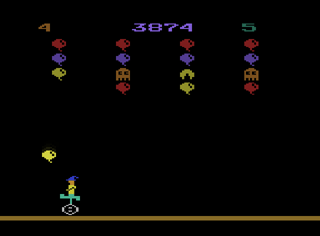
The arcade version of Bally/Midway's Kick-Man
(LEFT) and the VCS prototype (RIGHT).
Alex Leavens and I shared an office. He was working on Kick-Man at the time. I remember that the arcade programmers were very disappointed in the Kick-Man graphics and had a hard time believing that it was the best that could be generated by the 2600. Those guys were working with Z80 processors on custom boards that had tons of ROM and copious RAM; they had no clue how constrained the 2600 was. My first project at Bally/Midway was Solar Fox for the 2600. The plan all along was that it would be published by CBS Electronics, as would other 2600 titles developed at Bally/Midway. That was the only title that I worked on while at Bally/Midway, except for one small side project.
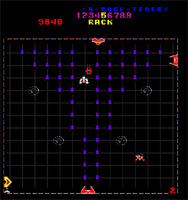
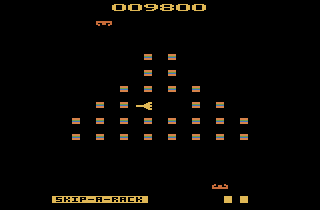
The arcade version of Bally/Midway's Solar Fox (LEFT) and the VCS
version (RIGHT).
What eventually led me to working at CBS is that I met Stuart Ross (Wings!) and Dick Balaska (Tunnel Runner) during a visit they made to Bally/Midway during the summer of 1982. Alex and I spent a lot of time with them, including some socializing after work. I got along well with both Stuart and Dick and stayed in touch with them. When my girlfriend completed graduate school in 1983, we moved back East and that’s when I started working for CBS.
Q: You mentioned doing some background display development for Ms. Pac-Man while at Bally/Midway. Did you mean to say the arcade version? VCS Ms. Pac-Man was developed by GCC (General Computer Corp), who were under contract with Atari, and was released in February 1983.
Bob Curtiss: One day Bill Adams asked me to take a look at a design for Pac-Man for the 2600. I don’t know who was developing that title (Ed.: Tod Frye at Atari), but it was someone outside of Bally/Midway. They had come up with a very pathetic-looking maze layout that looked nothing like the arcade version and they were claiming that it was the best that could be done on the 2600. Bill wanted to know if it was true, and I told him I would try to do better. I worked out a maze that was very close to the arcade version and it was used as leverage by Bally/Midway in their dealings with whomever it was that was developing it.
Q: What was your experience with working with the VCS hardware?
Bob Curtiss: There was a tremendous learning curve to write code for the 2600. Aside from the technical details of the 2600 itself, our tools were quite crude. We were using Atari 800 computers as development systems. The display was a TV set; the text editor displayed 20 lines of 40 characters each. The mouse hadn’t been invented yet, so all the editing was purely keyboard controlled. In order to test the code, we had to burn an EPROM and run it. That was at the beginning of my tenure there, but a few months later we received these amazing development systems from a company named Kontron. Those systems had Z80 processors and 40 line displays that were 80 characters wide. The best part was that they had in-circuit emulation; it was no longer necessary to burn an EPROM to test code, and we could even use breakpoints. That made a tremendous improvement to productivity, as you can imagine.
Q: How did you become a contract employee for Roklan? Do you recall when you first started working for them?
Bob Curtiss: About 7 months after I joined Bally/Midway, Alex Leavens quit. He had been having a very difficult working relationship with our boss, Bill Adams. Alex told me that he was going to do work for Roklan. Remember that he had worked closely with several people there while Roklan was developing Wizard of Wor. Alex and I stayed in touch after he left and one day he told me about the way things worked at Roklan. Most of the programmers worked on a contract basis and according to Alex, there was a lot more money to be made working that way. One day I visited Roklan and learned that they would like to have me working on games for them. Apparently they had more opportunities to do arcade ports than they had programmers to handle. It wasn’t the opportunity to make more money that interested me; it was the ability to work at home that I found attractive. I was getting burned out commuting in Chicago traffic, despite the fact that I lived inside the city and so my trip was opposite to the direction of most of the traffic. I really hated driving in bumper-to-bumper traffic day after day. So it was 9 months after I joined Bally/Midway that I left and started working as a freelancer for Roklan.
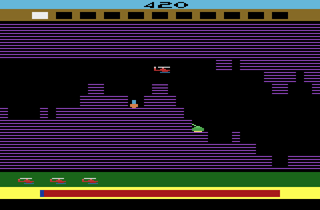
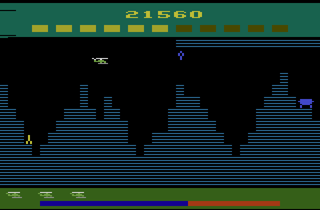
Early prototype version of Super Cobra by Mike Brodie
(LEFT) and released version by Bob Curtiss and Paul Crowley
(RIGHT).
Q: I know Super Cobra was one of the games you worked on at Roklan (for Parker Brothers). Mike Brodie at Parker Brothers had originally started working on a version, but apparently left before completing it, and turned to Roklan to start a new version.
Bob Curtiss: Super Cobra for the 2600 was the first game I worked on for Roklan. When I was close to completing it with a deadline looming, another programmer joined me and helped me finish it on time. His name was Paul Crowley and he was very talented.
Q: You mentioned that after Roklan, you briefly worked for CBS Electronics for 3 months, right before they closed down. You were working on an original two-player game that used two VCS units connected by serial cable via joystick ports, but due to the division shutting down, you didn't have a chance to complete the game. It's an interesting idea that at least one other company was working on; Amiga was developing a peripheral called the Power Module that would have allowed 2 people to play head-to-head over a phone line. They were developing a game similar to Seawolf called Depth Charge, with one player the submarine commander and the other the destroyer captain. Each player would have had their own screen display and set of commands. A prototype was found but it's incomplete. I'm guessing the CBS project would have allowed for a similar interactive experience, either over a phone line or a coax cable. Do you recall any notes or details about your game, or possibly have kept any materials related to it?
Bob Curtiss: The game was called Shove It! and it was very simple. The display was a 3-D perspective of 9 rectangular rods in a 3 x 3 matrix. You were viewing the ends of the rods, and could select each one via the joystick. When you pressed the fire button, the selected rod would move away from you – you would ‘shove it’ away from you. On the other player’s screen, the corresponding rod would move TOWARD them. The goal of the game was to shove one or more rods all the way to the other player’s side. Because so little time was spent developing that game, not much discussion had taken place regarding the eventual release. What we envisioned initially was that one player would take their VCS over to a friend’s house and they would connect the two units to two TV sets and to each other via a serial cable. I don’t know how realistic that was in 1983, but that was the concept.
Q: Did you only work on anything else for the VCS while there?
The other project I worked on for Roklan was a prototype of an air combat game that was inspired by the movie Firefox.
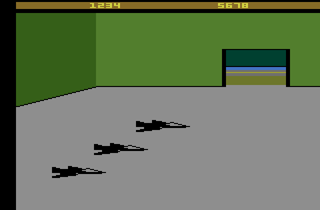
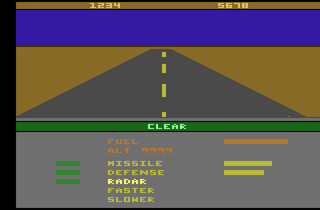
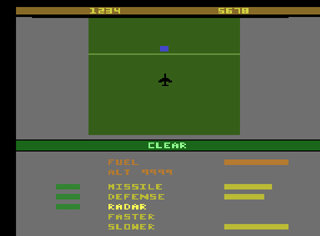
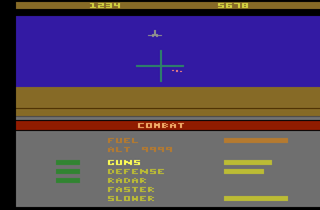
3 prototypes surfaced in 2019, all different
versions of the same game but with different names: Firefox, Fighter Command,
and Combat II.
Q: The Firefox prototypes (labeled Firefox, Fighter Command, and Combat II) that were recovered from former Roklan programmer Ronald Borta's archive are interesting. As you probably know, Atari’s first laserdisc coin-op game was based on the movie (LINK). A status listing from Atari circa 1984 was found that lists Firefox as unscheduled options for both the VCS and 5200/8-bit computers. Neither were assigned to anyone, and both are noted “KILL” (to denote the project was cancelled).


Q: How did you come to work for Absolute Entertainment? I'm guessing you worked for their Imagineering group, as Absolute were basically a publisher (until they absorbed Imagineering in 1992 and became a developer).
Bob Curtiss: I had done some work on an Atari 7800 game, working under contract for Tom Sloper at Activision. I don’t remember too much about the game except that it was a vertical scroller. That was my first 7800 project, so first I had to learn the 7800 system. I don’t remember how I had established the connection with Tom, but he invited me to come to Activision for an interview, and while I was there I discovered that Alex Leavens was working for him. I’m sure that Alex’s recommendation of me played a part in my getting the contract. Unfortunately, that game got cancelled during development, and so was never released. However, Tom suggested that I contact a company in New Jersey named Absolute Entertainment which had connections with Activision and was doing 7800 development. So that’s what led me to Absolute Entertainment.
Q: Did Dan Kitchen (who programmed VCS Kung-Fu Master) or Alex Demeo (who programmed Pete Rose Baseball) offer any help with your 7800 ports?
Bob Curtiss: Yes, I worked closely with both Dan and Alex. Neither of them was a 7800 programmer, though. Basically they provided me with insights into their game logic in the 2600 version of the game code. Each of them was the project manager for the port of their game to the 7800.
When I did the first game, Pete Rose Baseball, I had to take the source code from the 2600 version and edit it so that it would assemble on the Atari ST that we were using for the development system, because there were quite a few syntax changes required. I had this great text editor that ran on a Macintosh called BBEdit that had a macro feature I put to good use. Every time I found a different syntax change that needed to be applied throughout the code, I created a macro that would do it. I saved all these macros and reused them when I did the Kung Fu Master port. That ended up saving me a lot of time. Dan was surprised at how quickly I reached the first milestone, which was getting the game logic code to assemble without errors. What took one week on the first game took only a day on the second, thanks to those macros!
Both of those projects had ten-week schedules, which I met easily, with time left over to help create some of the game graphics. Both games used the original 2600 game logic with no changes; only the graphics were different on the 7800 versions. Even the sound effects were the original 2600 sound effects.
Q: Do you recall any other interesting projects at either Bally/Midway, Roklan, CBS, or Absolute Entertainment that were never released, either your own or someone else's?
Bob Curtiss: At CBS my friend Andrew Frank was working on an adventure game called Quest. He developed an algorithm to display a first-person point of view of an endlessly-appearing roadway as your character traveled forward. It was not a paved road, but more of a dirt road that you would be traveling along, riding a horse. He said at the time that the concept of the game was loosely based on the novel Don Quixote.
Another programmer at CBS, Alan Weiner, was working on algorithms to display 3-D graphics on the 2600. It was almost more of a research project than a game prototype.
Q: Did you ever attend any industry shows, such as AMOA or CES? If so, do you have any stories from your experiences?
Bob Curtiss: I never attended any video-game-oriented trade shows.
I attended the second Computer Game Developers Conference, which had around 125 participants. I think it was 1988 or 1989. I enjoyed that conference tremendously, but when I attended it again in 1992, it had grown to a huge size and I lost interest in the industry at that point.
Q: Do you still own any of your games for these systems, either as a keepsake, or to show friends or family?
Bob Curtiss: Only Pete Rose Baseball and Kung Fu Master.
Q: Which of your titles are your favorite, and what types of games in general?
Bob Curtiss: I didn’t really enjoy playing any of the video games that I programmed, although I did enjoy programming them. My favorite style of game is real time strategy. However, there is another ‘game’ that I worked on that I enjoyed quite a lot. It was released in 1992 just as the CD-ROM was becoming a popular consumer device. I teamed up with the late author R. A. Montgomery (of Choose Your Own Adventure fame) to co-produce a CD-ROM-based interactive story named Beyond the Wall of Stars. It was a very interesting experience involving a team of 8 to 10 people plus a handful of actors who appeared as characters in the story. It was not really a game and certainly hard-core video gamers would not consider it to be so. Literally, it was an interactive story in which the reader would choose courses of action at key decision points and had to solve a few puzzles here and there. I guess I’d call it ‘interactive fiction’; similar in concept to the Choose Your Own Adventure genre but much more interactive because it was computer-based.
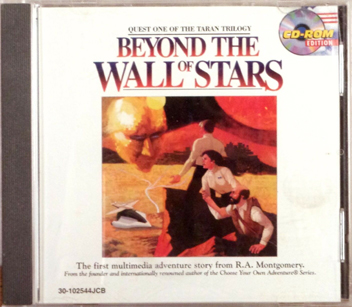
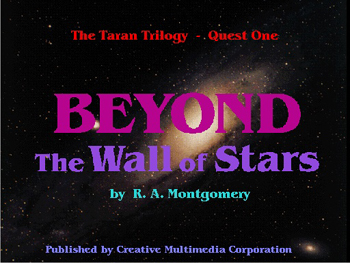
Beyond the Wall of Stars for the PC and Mac (LINK)
Q: What are your thoughts on how the industry has evolved?
Bob Curtiss: I haven’t really followed the industry since the mid-90’s.
Q: Are you still working in the industry?
Bob Curtiss: No.
Q: Looking back on your career, what was the most memorable moment (or moments) for you?
Bob Curtiss: The most memorable moment for me was when I visited Activision in the late ‘80s to interview with Tom Sloper. We had lunch together at a Japanese restaurant. It was my first time eating Japanese food and Tom provided me with various cultural insights while we were eating. One was that the chef prepares sushi in bite-sized pieces, and it’s expected that the diners will place each entire portion into their mouths; to try taking small bites out of it would be insulting to the chef. Another was that in Japan, a person doesn’t pour water into their own glass; they only pour it into the glasses of others at the table. As he told me this, he was refilling my own glass. I immediately got the idea but waited a few moments in an effort to be graceful about it, saying, “thank you” and taking a sip of water, and then I refilled his glass. He said, “thank you”, smiled, and took a sip. I think that was part of the interview, and I guess I passed.
Q: Have you stayed in touch with any of your former co-workers?
Bob Curtiss:
Yes I know Stuart Ross and have stayed in
touch with him over the years. Also Dick Balaska and 3 or 4
other people from CBS Electronics.
| GAME | SYSTEM | COMPANY | STATUS |
| Solar Fox | VCS/2600 | Bally/Midway (for CBS Electronics) | released |
| Pac-Man demo | VCS/2600 | Bally/Midway | not completed |
| Super Cobra | VCS/2600 | Roklan Corp. (for Parker Brothers) | released |
| Firefox/Fighter Command/Combat II | VCS/2600 | Roklan Corp. (for Parker Brothers) | not completed |
| Shove It! | VCS/2600 | CBS Electronics | not completed |
| Pete Rose Baseball | VCS/2600 | Absolute Entertainment | released |
| Kung Fu Master | VCS/2600 | Absolute Entertainment | released |
| Beyond the Wall of Stars | PC, Mac | Creative Multimedia Corp. | released |